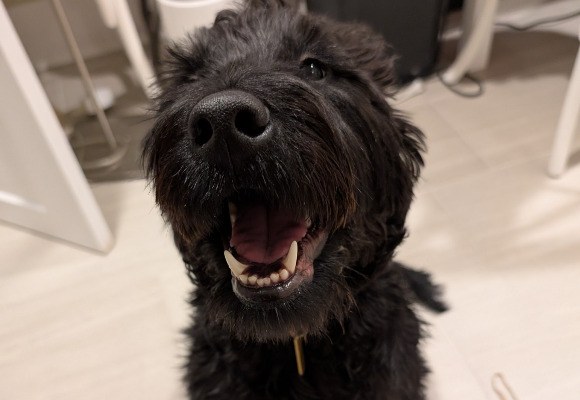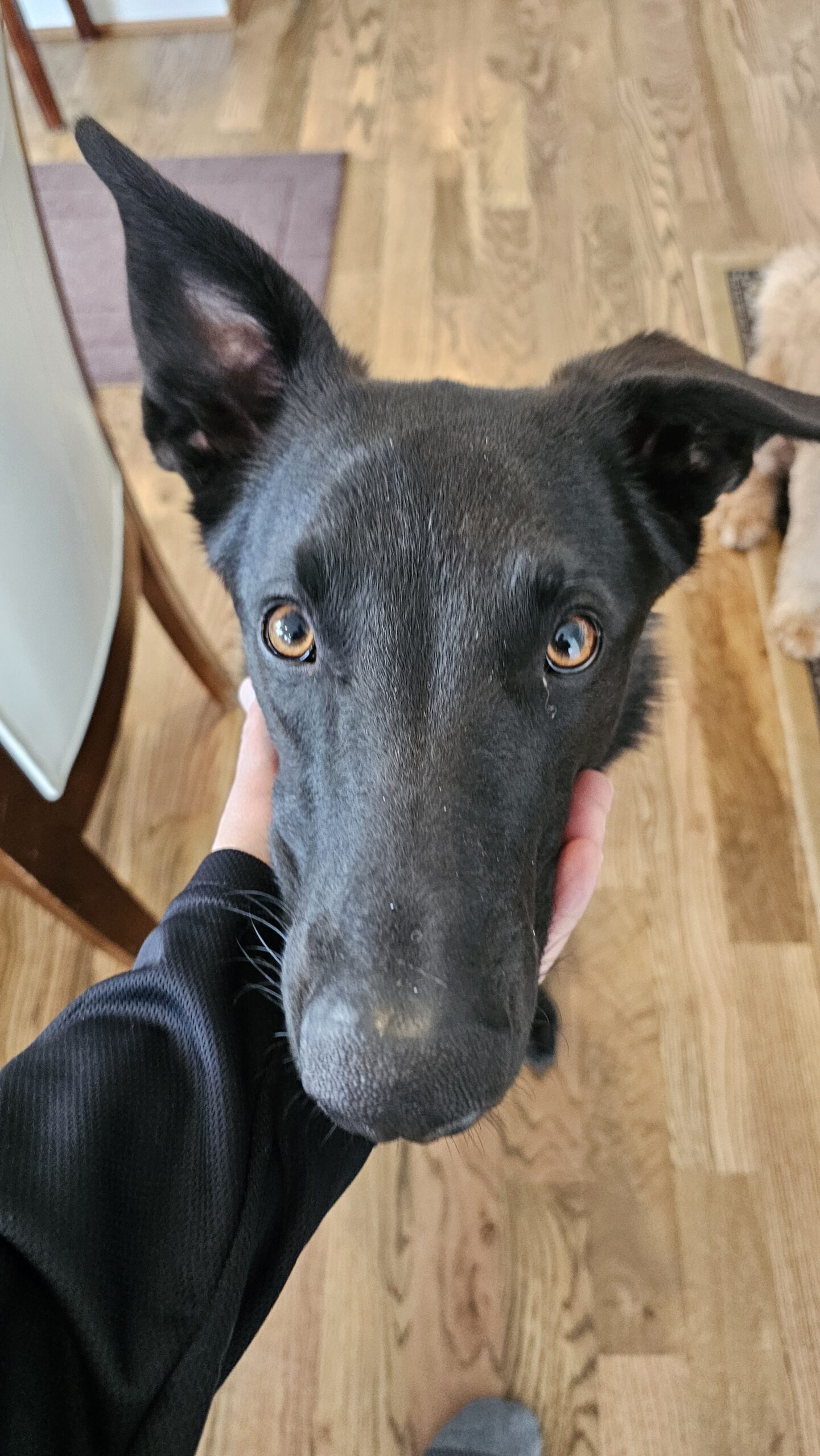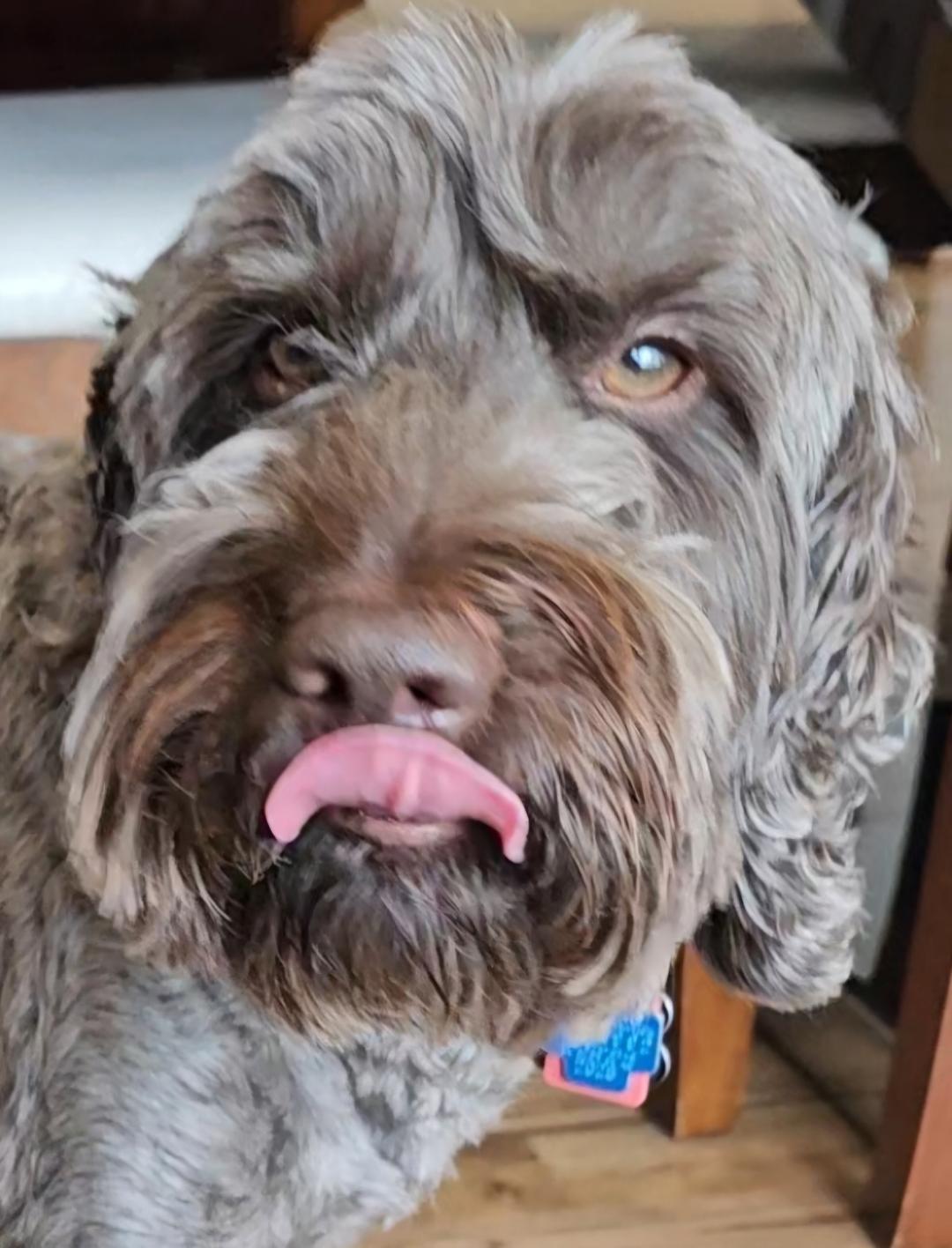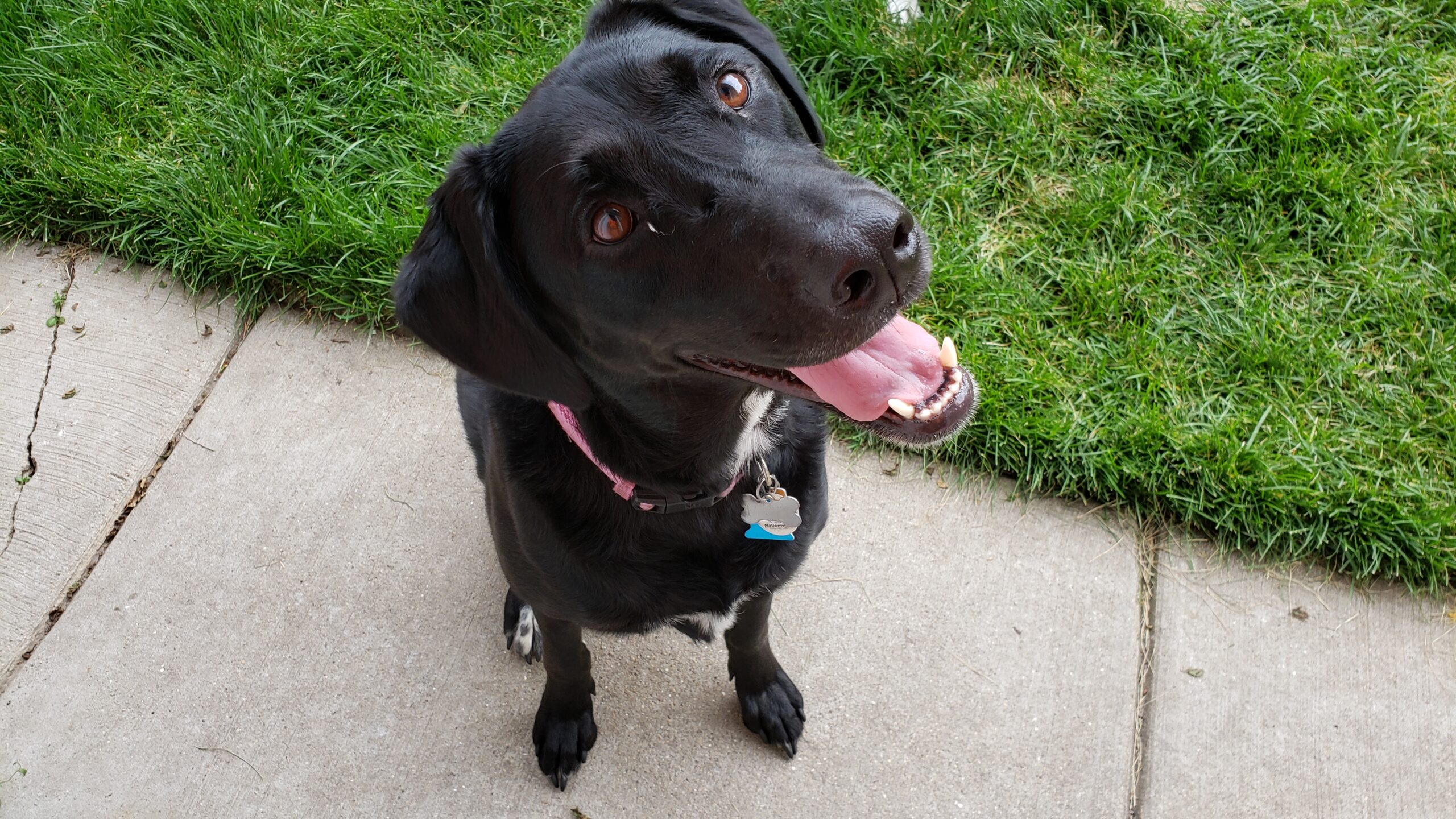May 27, 2025
If you want your dog to be calm at the vet, tolerant with children, and comfortable during grooming, play, and affection, early body handling exercises are essential. This often-overlooked part of early socialization can make the difference between a fearful dog and a cooperative companion.
 What Are Body Handling Exercises?
What Are Body Handling Exercises?
These are gentle, intentional touches that help your puppy learn to accept handling of their entire body—especially sensitive areas like the mouth, nose, eyes, ears, paws, and tail.
Think of it as teaching your dog that human touch = good things, not stress or discomfort.
 Why It’s Critical to Start Early
Why It’s Critical to Start Early
Puppies go through a socialization window that closes around 16 weeks. During this time, they’re most open to new experiences. That includes touching these areas:
-
Paws, toes and pads  (for nail trims)
(for nail trims)
-
Mouth, lips, gums and teeth  (for dental checks)
(for dental checks)
-
Underside of the ears  (for vet exams and grooming)
(for vet exams and grooming)
-
Tail wags and belly rubs  (for baths and towel drying)
(for baths and towel drying)
If these touches aren’t introduced early—slowly and positively—they can become triggers for fear, avoidance, or even aggression later in life. Several studies shows that puppies exposed to early handling are more resilient to stress as adults. NIH | Veterinary Ireland Journal | Purdue University
 How to Get Started: Gentle Steps to Success
How to Get Started: Gentle Steps to Success
Begin handling exercises when your pup is calm—after playtime or a nap is ideal. Keep sessions short, fun, and rewarding.
Here’s your beginner’s checklist:
-
 Eyes: Lightly stroke around the eyes with your fingers.
Eyes: Lightly stroke around the eyes with your fingers.
-
 Ears: Gently lift each ear flap and take a peek inside.
Ears: Gently lift each ear flap and take a peek inside.
-
 Mouth & Gums: Briefly lift the lips to expose the teeth.
Mouth & Gums: Briefly lift the lips to expose the teeth.
-
 Paws: Touch each paw pad and gently wiggle the toes.
Paws: Touch each paw pad and gently wiggle the toes.
-
 Tail: Stroke from the base to the tip.
Tail: Stroke from the base to the tip.
-
 Belly & Chest: Run your hand softly along the belly and chest.
Belly & Chest: Run your hand softly along the belly and chest.
Always pair each touch with praise or a tasty treat—this builds trust and positive associations.
 Check out this video of me handling Penny. She missed this kind of handling as a puppy, so you’ll notice subtle signs of stress like lip licks and yawns—but she’s learning! It’s never too late, even for adult dogs.
Check out this video of me handling Penny. She missed this kind of handling as a puppy, so you’ll notice subtle signs of stress like lip licks and yawns—but she’s learning! It’s never too late, even for adult dogs.
 Pro Tips for Tail-Wagging Progress
Pro Tips for Tail-Wagging Progress
-
 Use high-value treats (think: bits of chicken or cheese).
Use high-value treats (think: bits of chicken or cheese).
-
 Go slowly—your goal is comfort, not compliance.
Go slowly—your goal is comfort, not compliance.
-
 Stop at low levels of stress. Download the Stress Escalation Ladder to learn how to identify low level stress indicators.
Stop at low levels of stress. Download the Stress Escalation Ladder to learn how to identify low level stress indicators.
-
 Short daily sessions are better than long, infrequent ones.
Short daily sessions are better than long, infrequent ones.
-
 Involve the whole family, including kids (supervised).
Involve the whole family, including kids (supervised).
 Lifelong Benefits of Early Handling
Lifelong Benefits of Early Handling
Dogs that grow up with positive touch experiences are:
-
Easier to examine at the vet
-
More tolerant of grooming
-
Safer around children
-
Less likely to bite when injured
-
More confident in new environments
-
Less expensive—because you can do basic grooming at home
- More likely to enjoy physical affection
This tiny time investment now pays off for the rest of your dog’s life.
 Keep Building Positive Experiences
Keep Building Positive Experiences
Make body handling exercises part of your daily routine. Just like brushing up on basic obedience, a few minutes of calm handling helps prevent future problems.
Want to go deeper into early socialization? Don’t miss:
 The Truth About Puppy Socialization and Why Timing Matters
The Truth About Puppy Socialization and Why Timing Matters
Looking for tools to help? Browse our curated list of:
 Best Puppy Grooming Tools for Positive Handling at Home
Best Puppy Grooming Tools for Positive Handling at Home
 Conclusion
Conclusion
Body handling exercises are one of the kindest and most practical gifts you can give your puppy. It fosters trust, reduces fear, and lays the foundation for a lifetime of low-stress care.
Start today—your future dog (and your vet!) will thank you.
If you want your dog to be calm at the vet, tolerant with children, and comfortable during grooming, play, and affection, early body handling exercises are essential. This often-overlooked part of early socialization can make the difference between a fearful dog and a cooperative companion.
 What Are Body Handling Exercises?
What Are Body Handling Exercises?
These are gentle, intentional touches that help your puppy learn to accept handling of their entire body—especially sensitive areas like the mouth, nose, eyes, ears, paws, and tail.
Think of it as teaching your dog that human touch = good things, not stress or discomfort.
 Why It’s Critical to Start Early
Why It’s Critical to Start Early
Puppies go through a socialization window that closes around 16 weeks. During this time, they’re most open to new experiences. That includes touching these areas:
-
Paws, toes and pads  (for nail trims)
(for nail trims)
-
Mouth, lips, gums and teeth  (for dental checks)
(for dental checks)
-
Underside of the ears  (for vet exams and grooming)
(for vet exams and grooming)
-
Tail wags and belly rubs  (for baths and towel drying)
(for baths and towel drying)
If these touches aren’t introduced early—slowly and positively—they can become triggers for fear, avoidance, or even aggression later in life. Several studies shows that puppies exposed to early handling are more resilient to stress as adults. NIH | Veterinary Ireland Journal | Purdue University
 How to Get Started: Gentle Steps to Success
How to Get Started: Gentle Steps to Success
Begin handling exercises when your pup is calm—after playtime or a nap is ideal. Keep sessions short, fun, and rewarding.
Here’s your beginner’s checklist:
-
 Eyes: Lightly stroke around the eyes with your fingers.
Eyes: Lightly stroke around the eyes with your fingers.
-
 Ears: Gently lift each ear flap and take a peek inside.
Ears: Gently lift each ear flap and take a peek inside.
-
 Mouth & Gums: Briefly lift the lips to expose the teeth.
Mouth & Gums: Briefly lift the lips to expose the teeth.
-
 Paws: Touch each paw pad and gently wiggle the toes.
Paws: Touch each paw pad and gently wiggle the toes.
-
 Tail: Stroke from the base to the tip.
Tail: Stroke from the base to the tip.
-
 Belly & Chest: Run your hand softly along the belly and chest.
Belly & Chest: Run your hand softly along the belly and chest.
Always pair each touch with praise or a tasty treat—this builds trust and positive associations.
 Check out this video of me handling Penny. She missed this kind of handling as a puppy, so you’ll notice subtle signs of stress like lip licks and yawns—but she’s learning! It’s never too late, even for adult dogs.
Check out this video of me handling Penny. She missed this kind of handling as a puppy, so you’ll notice subtle signs of stress like lip licks and yawns—but she’s learning! It’s never too late, even for adult dogs.
 Pro Tips for Tail-Wagging Progress
Pro Tips for Tail-Wagging Progress
-
 Use high-value treats (think: bits of chicken or cheese).
Use high-value treats (think: bits of chicken or cheese).
-
 Go slowly—your goal is comfort, not compliance.
Go slowly—your goal is comfort, not compliance.
-
 Stop at low levels of stress. Download the Stress Escalation Ladder to learn how to identify low level stress indicators.
Stop at low levels of stress. Download the Stress Escalation Ladder to learn how to identify low level stress indicators.
-
 Short daily sessions are better than long, infrequent ones.
Short daily sessions are better than long, infrequent ones.
-
 Involve the whole family, including kids (supervised).
Involve the whole family, including kids (supervised).
 Lifelong Benefits of Early Handling
Lifelong Benefits of Early Handling
Dogs that grow up with positive touch experiences are:
-
Easier to examine at the vet
-
More tolerant of grooming
-
Safer around children
-
Less likely to bite when injured
-
More confident in new environments
-
Less expensive—because you can do basic grooming at home
- More likely to enjoy physical affection
This tiny time investment now pays off for the rest of your dog’s life.
 Keep Building Positive Experiences
Keep Building Positive Experiences
Make body handling exercises part of your daily routine. Just like brushing up on basic obedience, a few minutes of calm handling helps prevent future problems.
Want to go deeper into early socialization? Don’t miss:
 The Truth About Puppy Socialization and Why Timing Matters
The Truth About Puppy Socialization and Why Timing Matters
Looking for tools to help? Browse our curated list of:
 Best Puppy Grooming Tools for Positive Handling at Home
Best Puppy Grooming Tools for Positive Handling at Home
 Conclusion
Conclusion
Body handling exercises are one of the kindest and most practical gifts you can give your puppy. It fosters trust, reduces fear, and lays the foundation for a lifetime of low-stress care.
Start today—your future dog (and your vet!) will thank you.
 Why Gut Health Matters for Dogs
Why Gut Health Matters for Dogs Natural Gut Helpers Most Dogs Love
Natural Gut Helpers Most Dogs Love Libby’s 100% Canned Pumpkin
Libby’s 100% Canned Pumpkin Plain Greek Yogurt
Plain Greek Yogurt My Surprise Find: Bernie’s Perfect Poop
My Surprise Find: Bernie’s Perfect Poop How I Use It at My Daycare
How I Use It at My Daycare Final Thoughts
Final Thoughts


 What Is Foraging Enrichment?
What Is Foraging Enrichment? Why Foraging Is So Powerful
Why Foraging Is So Powerful Blanket Foraging: A Simple, DIY Activity
Blanket Foraging: A Simple, DIY Activity Pro Tip: Use high-value treats that really motivate your dog.
Pro Tip: Use high-value treats that really motivate your dog. Download my FREE document on The Blanket Foraging
Download my FREE document on The Blanket Foraging Want to see it in action?
Want to see it in action? No More “Free” Treats
No More “Free” Treats Enrichment Isn’t Just a Trend—It’s a Need
Enrichment Isn’t Just a Trend—It’s a Need
 Why a Reliable Name Response Matters
Why a Reliable Name Response Matters They glance at you… but no reward follows.
They glance at you… but no reward follows. Next time, they don’t bother looking.
Next time, they don’t bother looking. The fix: Use a consistent verbal praise marker (like “Yes!” or “Good boy!”) immediately followed by a
The fix: Use a consistent verbal praise marker (like “Yes!” or “Good boy!”) immediately followed by a  Generalization: Training for Real-Life Situations
Generalization: Training for Real-Life Situations Quiet indoor space
Quiet indoor space  Indoor with mild background noise
Indoor with mild background noise Backyard or enclosed outdoor area
Backyard or enclosed outdoor area Front yard or sidewalk
Front yard or sidewalk Local park or trail
Local park or trail Outside a dog park or school at pickup time
Outside a dog park or school at pickup time Don’t jump from step 1 to step 6 overnight and insert smaller steps when needed. i.e. Between steps 2 and 3 add more background noise if your dog is failing too often when you go outside.
Don’t jump from step 1 to step 6 overnight and insert smaller steps when needed. i.e. Between steps 2 and 3 add more background noise if your dog is failing too often when you go outside. Use the same verbal marker (e.g., “Yes!” or “Good dog!”) every time your dog turns toward you.
Use the same verbal marker (e.g., “Yes!” or “Good dog!”) every time your dog turns toward you. Follow the marker immediately with a high-quality meat treat—the gold standard in positive reinforcement.
Follow the marker immediately with a high-quality meat treat—the gold standard in positive reinforcement. Avoid repeating the name if your dog doesn’t respond. Try again later with fewer distractions.
Avoid repeating the name if your dog doesn’t respond. Try again later with fewer distractions. Don’t use the name before giving a correction (e.g., “Fido, NO!”), as this can poison the cue.
Don’t use the name before giving a correction (e.g., “Fido, NO!”), as this can poison the cue. Once the response is solid, you can use a variable reinforcement schedule where you only reward 75% of the time for a few days/weeks, then 50% of the time for a few days/weeks, and finally 20% of the time. The Variable reinforcement is taking full advantage of the classical conditioning you’ve completed. Your dog has received a reward so often and consistently that they have come to associate the praise with the reward. You’ve taught your dog persistence, and they will perform at an even higher level.
Once the response is solid, you can use a variable reinforcement schedule where you only reward 75% of the time for a few days/weeks, then 50% of the time for a few days/weeks, and finally 20% of the time. The Variable reinforcement is taking full advantage of the classical conditioning you’ve completed. Your dog has received a reward so often and consistently that they have come to associate the praise with the reward. You’ve taught your dog persistence, and they will perform at an even higher level. Why the Name Game Works
Why the Name Game Works Your dog is calm and awake
Your dog is calm and awake The environment is distraction-free
The environment is distraction-free You can gradually escalate the challenge
You can gradually escalate the challenge Final Thoughts: Earn Their Ears
Final Thoughts: Earn Their Ears
 (for dental checks)
(for dental checks) (for vet exams and grooming)
(for vet exams and grooming) (for baths and towel drying)
(for baths and towel drying) Ears: Gently lift each ear flap and take a peek inside.
Ears: Gently lift each ear flap and take a peek inside. Mouth & Gums: Briefly lift the lips to expose the teeth.
Mouth & Gums: Briefly lift the lips to expose the teeth. Go slowly—your goal is comfort, not compliance.
Go slowly—your goal is comfort, not compliance. Stop at low levels of stress.
Stop at low levels of stress.  Short daily sessions are better than long, infrequent ones.
Short daily sessions are better than long, infrequent ones. Involve the whole family, including kids (supervised).
Involve the whole family, including kids (supervised). Keep Building Positive Experiences
Keep Building Positive Experiences




 Using English too early
Using English too early Weak or missing rewards
Weak or missing rewards Inconsistent expectations
Inconsistent expectations Rewarding bad behavior accidentally
Rewarding bad behavior accidentally When inconsistency is good
When inconsistency is good